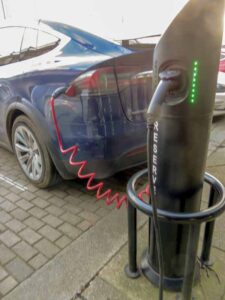There’s a lot circulating around about how we might emerge from Covid-19 by using its disruptions to embrace sustainability. Now it seems that Boris is proposing a big car scrappage scheme to subsidise electric vehicles, together with encouraging bikes and making electric scooters legal. B ut social and economic transformations involve a few more wheels within wheels than such simplistic quick fix actions as these. Good design emerges from understanding people, their behaviours and their practices and it could be that indirect changes through behaviours could end up far more significant.
ut social and economic transformations involve a few more wheels within wheels than such simplistic quick fix actions as these. Good design emerges from understanding people, their behaviours and their practices and it could be that indirect changes through behaviours could end up far more significant.
One issue about the uptake of electric vehicles has been the deep rooted concern that, once electric vehicles become widespread, there will be a massive surge in early evening electricity demand. This would be when commuters arrive home and all plug in their cars at around the same time causing a surge in power demand. That would require building numerous new power stations, which would also need substantial investment to reinforce power distribution networks. If that demand could be shifted off peak then the situation is manageable, but how can this be done? That has led to a lot of technological proposals for a smart meter/smart vehicle interface managing charging cycles, plus proposals for variable tariffs that would punitively charge motorists for plugging in vehicles during the early evening.
One thing taken for granted in all these studies was that everyone would have a traditional 9-5 job, driving off to work and back. That traditional pattern was already breaking down before Covid-19 struck. One thing the lockdown has done has been to provide a mass experience to both employees and employers of homeworking and flexible working practices. This got me thinking about how this might change travel patterns. Then I saw an article in this week’s Radio Times[1] by the historian David Olusoga. OK – that’s not a mainstream design studies journal, but it is relevant and Olusoga is a very respected social historian with strong OU broadcasting links. His point is that it was technology that in the 19th century shifted work from the home to the factory and the office, and now it is technology that is allowing us to shift work back to the home. The technology enabling homeworking already existed, but had been applied in a somewhat limited and contained manner.
What the pandemic has done has got businesses and employees to rework their practices and procedures. So, rather than homeworking technologies being an occasional ancillary feature of a design built around travelling to a workplace, homeworking has become the core design to which occasional travelling to a business location is an ancillary feature. The lockdown experience of this reconfiguration has surprised both employees and employers alike who have both come to appreciate that there are real benefits in this paradigm shift. Is the office on its way to being consigned to history?
So, what does that mean for charging electric vehicles? Let’s connect some of those circles that you find. Rather than throwing money at technological hardware and power system upgrades, maybe a better design strategy is to put in place support measures for the adoption of working behaviours that structurally change evening peak demand for electricity. If more people have flexible working practices, work at home or blend homeworking with office contact time, then that evening peak could flatten without expensive grid upgrades, complex technological fixes or politically unpalatable fiscal sticks.
The ‘new normal’ could lead to a new design paradigm that supports sustainability in a totally unexpected systemic way.
[1] 13th June p.7

Leave a Reply